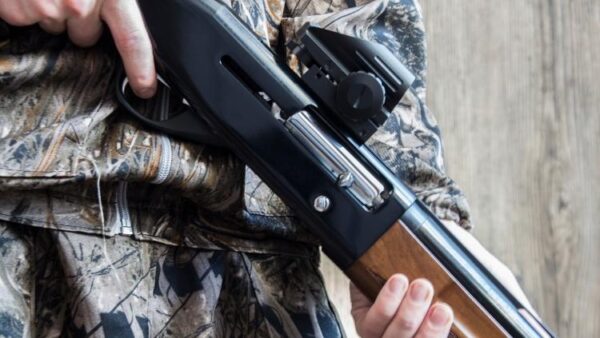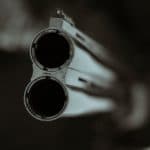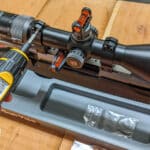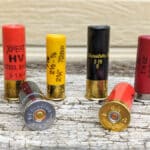Shotguns are excellent tools for hunting, sport shooting, and self-defense. They’re versatile tools and are easy to pick up once you get the knack of pointing the firearm.
Shooters transitioning to shotguns from rifle shooting often bring some of their training. Especially prevalent is the desire to assist their aim with a scope or red dot, the same as they have on their rifle.
This leads to the common question:
Should you install an optic on your shotgun?
Naturally, the answer depends on how you’re using your shotgun. But you don’t have to look at a complicated table to figure out if you should use an optic with your shotgun.
The trick is to answer this question:
Are you shooting a stationary target or a swiftly moving target?
Optics on shotguns help improve your precision when shooting targets either moving slowly or not moving at all. However, they can slow you down when taking quick shots at flying birds or clays by distracting your eyes.
The reason this is the case may not be obvious, so we’ll cover the hows and whys optics are sometimes helpful and sometimes harmful.
Then we can answer what type of optic is best for your shotgun!
The Basics of Shotgun Sights
You may have noticed that I used the word “point” to describe the process of bringing a shotgun on target instead of the word “aim.”
That’s because shotgun shooting is more instinctual than rifle shooting. It’s kind of like traditional archery that way.
When shooting a rifle, or a handgun, you ensure a good hit by lining up the front and rear sights and superimposing them over the target. If the gun has been sighted in properly, the point of aim and point of impact will be the same.
Those guns function this way because they fire a single projectile that travels in a (hopefully!) consistent arc.
An optic lets you see that point of aim without having to align the iron sights, thereby improving speed and accuracy.
Shotguns, on the other hand, fire a cloud of projectiles, called the shot, in a semi-random pattern. A precise point of aim only tells you where the center of this cloud is likely to impact. Heck, no pellets may hit at the exact center!
This is why shotguns are a great choice against birds, from doves to quail.
The shot is also slower than the typical bullet. This introduces a noticeable travel delay, which becomes essential when shooting at a moving target such as a clay pigeon or the duck you just called in.
(I’m ignoring slugs for now but don’t worry, I’ll get to them in a little bit!)
For these reasons, shotgunners don’t bother aligning sights the same way a rifle shooter would. You need to be fast, but you don’t need to be nearly so precise.
Leading the target and following through after pulling the trigger are more important. And this means keeping both of your eyes on the prize.
Instead of iron sights, most shotguns have a bead atop the barrel, near the tip. It’s a quick point of reference that doesn’t distract your view of the target. This process is handled subconsciously once you’ve gotten used to a shotgun.
Some shotguns have a rib, a second bead halfway down the barrel, or both. These are tools to help ensure you’re consistent in mounting the shotgun. Your view of the bead(s) must be the same every time.
Because you’re focused on the target instead of the gun, you can direct your attention toward getting a quick hit.
Some shotgunners are so consistent they can remove their front bead and still hit 25 out of 25 clays!
Is It Worth Putting a Red Dot on a Shotgun?
So, what does an optic add to this equation?
Precision.
Now, reflex sights are assuredly faster than a rifle’s iron sights, but that glowing reticle draws the eye’s attention. This can confuse your sight picture and slow down your shooting compared with bead sights, which blend into your subconscious.
Scopes, magnified or unmagnified, are guilty of slowing you down even further. But they still have their uses.
This means that shotgun shooting that relies on snapshots is hampered by adding a red dot sight.
I’ve seen people use red dots at the trap line, but it’s rare for them to outshoot someone with a bead.
On the other hand, if you need extra precision in your shooting—say, because you’re hunting deer with slugs—then an optic is worth adding to your shotgun.
An optic is a worthwhile addition to your shotgun against anything that moves at about human speed or slower. It’ll likely slow you down when shooting at anything running on the ground or flying through the air, though.
I’m not being definitive here because there are exceptions to both of my statements above. I know people who shoot pheasants better with a red dot than without. And I know people who can put a slug in a bullseye at 100 yards with a front bead but can’t seem to do that consistently with a scope.
You may have to experiment to see whether or not adding an optic is worth it to you.
Hey, that’s more range time, right?
Types of Shotgun Optical Sights
Red dot sights are the most commonly used shotgun optics but aren’t the only available options.
Let’s look at the three main types of shotgun optics to see which will work best for you.
Red Dot Sights
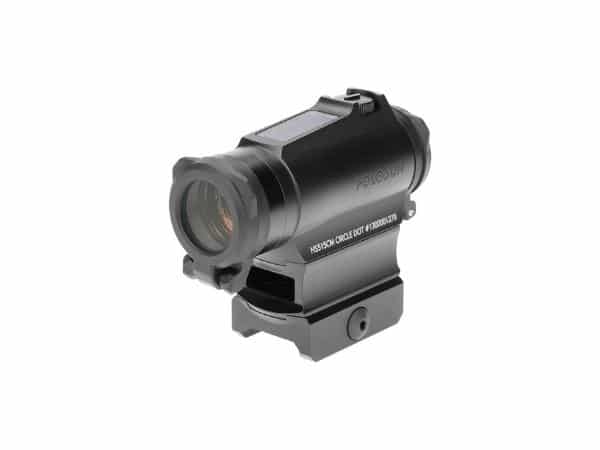
Red dots, also called reflex sights, impose a floating reticle in front of your eyes.
These sights are available as an enclosed tube or with an open emitter, shining their light upon the window to reflect the dot back at your eyes.
These optics work well with many shotguns because they let you focus on the target with both eyes.
Tube-style red dot sights are bulkier and heavier than ones with open emitters but are immune to a bit of snow or muck getting inside to block said emitter. The open-style reflex sight is lighter and smaller, especially the ones designed for use on a pistol.
You’ll often see these sights on the shotguns used by 3-gun competitors and for tactical shotgunning.
I’m a fan of the circle and dot style because the circle gives you a rough estimate of where the pellet cloud will impact, so you can still use your shotgun for snapshots.
I currently have a Holosun HS515CM on my self-defense shotgun, though I am planning to replace it with an HS507C soon to lighten it up.
Holographic Sights

Holographic sights are similar to red dot sights, except they use a laser to form a hologram as the reticle.
This hologram is unlike the reflected light of a reflex sight because it doesn’t need the view window to stay intact. Holo sights are an excellent choice for environments where you need extra durability.
Holographic optics also compensate for parallax better than red dot sights. In practical terms, this means you’ll be more accurate even if your shooting stance is slightly off.
However, holo sights are larger and heavier than any red dot sight.
I had my EOTech 512 on my self-defense shotgun for a time, but it was just too much weight, so I took it off.
Some people like them for self-defense or 3-gun shooting, though.
The EOTech XPS2 would be the better choice in this case because its smaller weight affects the shotgun’s balance less.
Shotgun Scopes
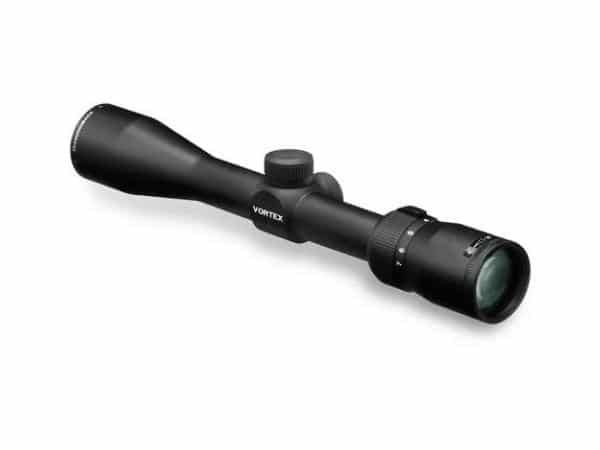
A scope may seem like a silly addition to a shotgun, but there are two use cases where you may want to use a magnified optic.
The first use is obvious: Slugs.
Shotgun slugs are like large, slow rifle bullets, so a more rifle-like setup is common with dedicated slug guns.
4x is the most common shotgun scope magnification, though I’ve seen some shotguns sports glasses that go up to 7x!
Turkey hunters may appreciate some magnification as well.
Unlike other birds, turkeys are often taken with as tight a choke as possible at a comparatively long range. And those darn birds seem to wear Kevlar jackets, so you need to put as much shot into the head and neck as possible.
This means precision wins out over speed.
The Vortex Diamondback 2-7×35 is my favorite shotgun scope. It’s inexpensive and has enough magnification to put that slug precisely where you want it to go.
Who Should Install an Optic on their Shotgun?
You probably have a good idea of whether or not installing a red dot or other types of optics can help your shotgunning by now.
For ground-based shooting, optics are a good choice. For wing shooting, however, optics tend to lose out to the good ol’ bead sight.
That’s not always the case, though.
For example, if you’re hunting rabbits, you need to swing on target rapidly and have great follow-through, much like partridge hunting. So, any optic may slow you down.
Upland bird hunting especially depends on well-placed rapid shots against panicking birds. My upland hunting shotgun will stay optic-free.
Conversely, if you’re cross-eyed dominant, a red dot sight can improve your ability to break clays by making your brain focus on the eye’s input in line with the shotgun.
And red dot sights are becoming more common for hunting slower birds such as ducks and doves. In that case, it’s a personal preference. I’ve tried red dots against even slow-flying targets, and my ability to track the target was impaired enough to not guarantee a killing blow against a live animal.
We don’t want to harm any animal and let it suffer, so all my wing shooting is done without an optic.
With these facts in mind, here’s a chart of various shotgunning disciplines and whether or not a certain type of optic can be helpful:
| Use | Red Dot Sight | Holographic Sight | Scope |
| Upland Hunting | No | No | No |
| Rabbit Hunting | No | No | No |
| Waterfowl Hunting | Maybe | Maybe | No |
| Deer Hunting | Maybe | Maybe | Yes |
| Turkey Hunting | Maybe | Maybe | Yes |
| Clay Shooting | No | No | No |
| 3-Gun Competition | Yes | Yes | No |
| Self Defense | Yes | Yes | No |
| Survival | Yes | No | No |
| Recreational Blasting | Why not? | Sure | Nah |
Pros and Cons of Mounting a Red Dot on a Shotgun
Still unsure if a red dot sight is right for you?
Here’s a list of arguments in favor of and against adding a reflex sight to your gun.
Pros
- Can make your shotgun more precise (especially slugs)
- Added visibility in low-light situations
- Can help with issues such as cross-eye dominance by drawing the eye’s attention
- Doesn’t require a strict form for accuracy, so those awkward shots are less awkward
- May allow for a more natural and comfortable head position
Cons
- The reticle can distract the eye, slowing your shot or affecting your ability to lead the target properly
- Can run out of batteries or break, leaving you to rely on pointing anyway, just with a useless hunk of metal in front of your eye
- Glare can reflect off the glass
- Susceptible to snow and mud on the emitter or lens
- Increases the upfront cost of using your shotgun
Conclusion
Unlike rifles, shotguns are not always upgraded when you install an optic.
Shotgunning involving instinctive shooting keeps your shotgun barrel and bead out of focus. Adding a bright dot to the picture may be distracting and interfere with your ability to lead a swift-moving target properly.
However, a red dot sight can be an excellent choice when you want to use your shotgun as a precise weapon.
And for slugs or turkey loads, a scope can improve your ability to put down that animal with one shot. That’s something we should always strive for.
Ultimately, though, the edge you get from an optic on a shotgun isn’t quite as strong as when you put the same optic on a rifle.
Try it out, though. You may be surprised at how much you like having a circle to show your shotgun’s pattern!
FAQs
Can You Mount a Sight on A Shotgun without a Picatinny Rail?
Many shotguns that don’t have Picatinny rails are compatible with saddle mounts. You can also buy barrel clamps with a short section of rail for an optic.
Why Would You Have a Scope on a Shotgun?
Scopes can be used on shotguns to increase your effective range. This is primarily useful when hunting deer and turkey.
Do You Need an Optic on a Shotgun?
No shotgun needs an optic to be useful. If you have a consistent mount with a shotgun that fits you properly, you don’t need the front bead. A shotgun sight can improve your speed and precision in some cases, though.
Can You Install Pistol Red Dot Sights on a Shotgun?
Small reflex sights such as the Trijicon RMR and Holosun 507 are not only compatible with shotguns but also a great choice because of their light weight and small size.
Related: Hunting vs Sporting Shotguns: What They Are & Comparison

